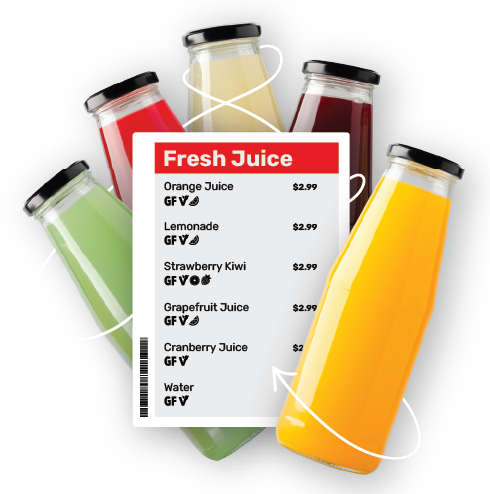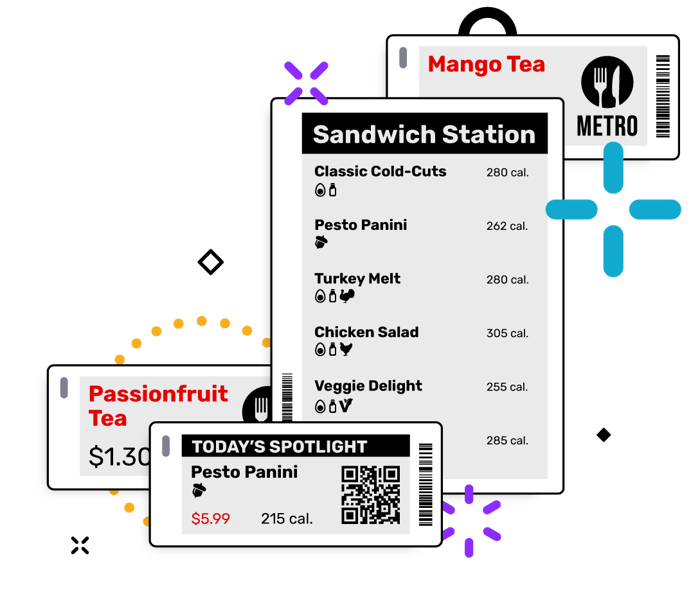If you haven’t already looked at ways to make your foodservice operation more sustainable, you should! About 68% of savvy, modern-day consumers want to support companies that reduce their environmental impact, according to Forrester Research.
Which is exactly why you should consider investing in digital labels for displaying your food information.
These nifty, e-ink devices are new to the non-commercial foodservice industry, but are poised to make a big impact on operational efficiency and the customer experience. However, one of the biggest benefits of digital labels is their ability to improve your sustainability.
Here’s why:
Digital labels reduce paper waste.
It seems obvious, but when you use technology like digital food labels in your operation instead of printed paper labels, you’re no longer producing the waste that comes with that traditional – but outdated – labeling method.
Paper labels can’t produce that much waste, can they? Well, consider that back in 2017, it was estimated that UK printing companies were sending over 264 million pounds of label waste to landfills in that region alone!
While your operation isn’t producing millions of pounds of waste on your own, every label thrown away is one less chance to be sustainable, especially when not all labels can be recycled (thanks a lot, sticky labels).
They have a longer lifespan than paper.
The beauty of digital labels is that they just last longer than paper. Because you can update the information displayed on their screens digitally, you never have to throw them out each time there’s a change to your food data.
Digital food labels utilizing e-ink technology operate off battery power, which means they can last up to 5 years or more before needing a new battery. Paper labels usually never last more than a day – at best a week – before needing to be replaced for accuracy’s sake.
Additionally, the physical labels themselves survive far longer than the life of their batteries. Simply put, foodservice operators concerned about sustainability don’t need to look any further than these digital helpers!
Digital food labels cut down on food waste.
Food waste is one of the biggest concerns in the foodservice industry today, both commercial and non-commercial. The USDA estimates that 30-40% of the U.S.’s food supply alone turns into food waste!
This is one area where digital labels can help out, because they can provide more transparency about items to help customers make informed, appropriate decisions for their personal tastes. For example, listing ingredients or a description about what flavors to expect can help them choose something aligned to their preferences.
The transparency of digital labels helps reduce the chance that items will be thrown away by customers because they don’t enjoy the food. In buffet-style settings, this benefit becomes critical, because sampling happens more often if guests aren’t sure what your items might taste like, and you could end up seeing more food waste if your customers decide they don’t like one (or more) of your offerings.

Digital food labels lower your carbon footprint.
Another way digital labels help your operation become more sustainable is by their very nature: they’re highly energy-efficient because what energy they do consume is from batteries, and they are often made from recyclable materials.
Can battery-powered labels really make a difference on your energy consumption? For sure! In an example from the grocery world, Kroger installed easy-to-read LED shelf edge displays in some of its stores, and in turn lowered the intensity of overhead fluorescent lights. Kroger saved more than 135 million kilowatt hours in 2017 and won the 2018 Energy Star Partner of the Year Award from the U.S. EPA.
Remember, too, that some digital labels can be recycled, since they can be disassembled and parts repurposed for new labels or other tech products. This only further contributes to the reduction of your carbon footprint and environmental impact as an operation.
When 60% of people around the world consider sustainability an important part of their decision-making process, it’s time your operation takes a look at the value of digital labels. Not only can you become more sustainable in your labeling process, but you’ll also cut down on the tedium and time wasted on updating traditional labels!
Ready to make the next step towards sustainability?

